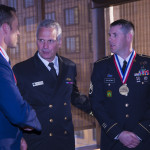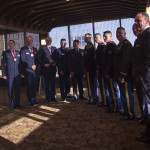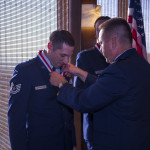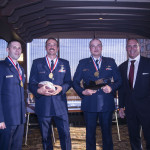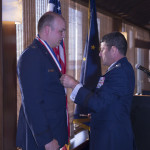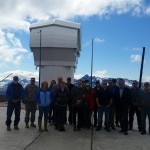On top of the world, with a 360 degree view of anything coming over the Northern Hemisphere that would threaten our nation is Alaska, our 49th state. Alaska provides the shortest point for air lift and air power projection from the United States to Asia, Europe and the Middle East. During World War II, the United States sent thousands of aircraft to Russia and China in the Lend-Lease deal that provided the needed airpower for Russia to not be defeated.
Alaska’s geostrategic location makes it the only state from where one can defend all 50 states from a long range ballistic missile attack coming from the Northern Hemisphere, both east and west, from Hawaii to Florida. The decision to locate the bulk of our nation’s long range interceptors in Alaska was driven during the Clinton Administration by Senator Ted Stevens (R-AK) and Senator Daniel Inouye (D-HI). The previous U.S. missile defense system, 1976 Vanguard system, was located in North Dakota. Neither Alaska nor Hawaii could not be defended against from North Dakota and with the demonstration and development of the North Korean ballistic missiles in the 90s, a decision was made to build a defense for the nation against this threat. The first interceptor was put in place in 2004 in the middle of Alaska at Fort Greely. Today, the site has 27 operational interceptors.
This is not the first time the United States has strategically placed an air defense capability in Alaska designed to counter nuclear threats coming from the northern hemisphere. From 1959 to 1979, the U.S. Army deployed a Nike Hercules interceptor defense on top of the mountains and on the flats around Anchorage to defend against the Russian Bear Bomber squadrons. These rudimentary interceptor missiles were nuclear tipped with a range around 75 miles and used proximity fragmentation to detonate within the center of the flying Russian squadron in the atmosphere. The Site Summit, on top of the mountain overlooking Anchorage, was the showpiece for deterrence with its radars located at the peak and the interceptors located a little bit below. President John F Kennedy visited it, as did Frank Sinatra and Marilyn Monroe at its height. By the 1960s there were 274 Nike Hercules Batteries and 10,000 interceptors across the United States.
Today there are 30 U.S. Army Ground based interceptors and 2 sites, one in Alaska and one in California. Both are non-nuclear and use hit-to-kill, metal-on-metal kinetic energy for accuracy and confidence. Today we have decoupled the radars from the interceptor site and now leverage all existing early warning and tracking radars at sea, in space, and on land that can see the threat to use for early warning and persistent tracking from birth to death of the threat. Two of the main land-based sensors for tracking the North Korean missile threat are located in Alaska; at Shemiya on the outer tip of the Aleutians and at Clear Air Force Station in the center of Alaska. Next year, the Early Warning Radar at Clear will finish its BMD upgrade and will directly link into the GBIs further south at Fort Greely, as well as into the main network of sensors giving our national missile defense system more redundancy and direct communication to reduce latency.
The Alaska National Guard mans and operates the Ground Based Missile Defense sites in Fort Greely and Clear Air Force Station. Each have series of crews that take shifts for the 24/7 operations. These soldiers and airmen are the vital component of the system and the success of its mission no matter how technologically advanced these systems are. In recognition of their tremendous responsibility to defend and protect the 300 million Americans in all 50 states, we at MDAA, along with their commanding officers and flag officers each year recognize the very best crew from the Ground Based Interceptor system at Fort Greely, and the EWR sensor system at Clear Air Force Base. We also recognize the single best Missile and Air Defenders from both units for the year with the Senator Ted Stevens Memorial Award.
We held the 2015 Alaska Missile Defender of the Year event over this past weekend in Anchorage, Alaska. We were honored to have U.S. Senator Dan Sullivan (R-AK), Missile Defense Agency Director Vice Admiral James Syring; Commander of U.S. Alaska Command, Lieutenant General Russell Handy, Assistant Adjutant General of the Alaska Army National Guard Colonel Joseph Streff, Commander of the 213th Space Warning Squadron Lieutenant Colonel John Oberst, and the publisher of the Anchorage Daily News and Alaska Dispatch, Ms. Alice Rogoff join us to recognize the excellence and leadership of our winners, and the teams they represent.
|
The Winners of the Ted Stevens Memorial Award in 2015 are:
 Captain Eric L. Vantrease
Chief Standardization and Evaluation Officer, 213th Space Warning Squadron
Alaska Air National Guard
 Master Sergeant Thomas E. Wright II Assistant Operation Superintendent, 13th/23th Space Wing Squadron
Alaska Air National Guard
The Winners of the 2015 Missile Defender of the Year of the Alaska Air National Guard are:
 First Lieutenant Micah Hanauer Crew Commander, Missile Warning Operations Center, 213th SWS
 Technical Sergeant Brian C. Rowbotham
Crew Chief, Missile Warning Operations Center, 213th SWS
The Winners of the 2015 Missile Defender of the Year Award for Best Crew are:
Alpha Crew, 49th Missile Defense Battalion, Alaska Army National Guard
 Major Jeremy Shepherd
Senior Tactical Director
 Captain Gilberto Ortiz
Battle Analyst/Deputy Director
 First Lieutenant Cody J. Hennelly Sensor Operator
 Staff Sergeant Michael Diachenko
Engagement Control Team Leader
 Sergeant Josef R. Carstens Communications Operator |



